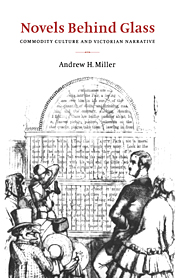Book contents
- Frontmatter
- Contents
- List of illustrations
- Acknowledgements
- Introduction
- 1 Longing for sleeve buttons
- 2 Spaces of exchange: interpreting the Great Exhibition of 1851
- 3 The fragments and small opportunities of Cranford
- 4 Rearranging the furniture of Our Mutual Friend
- 5 Owning up: possessive individualism in Trollope's Autobiography and The Eustace Diamonds
- 6 Middlemarch and the solicitudes of material culture
- Afterword
- Works cited
- Index
6 - Middlemarch and the solicitudes of material culture
Published online by Cambridge University Press: 17 August 2009
- Frontmatter
- Contents
- List of illustrations
- Acknowledgements
- Introduction
- 1 Longing for sleeve buttons
- 2 Spaces of exchange: interpreting the Great Exhibition of 1851
- 3 The fragments and small opportunities of Cranford
- 4 Rearranging the furniture of Our Mutual Friend
- 5 Owning up: possessive individualism in Trollope's Autobiography and The Eustace Diamonds
- 6 Middlemarch and the solicitudes of material culture
- Afterword
- Works cited
- Index
Summary
In 1863, twelve years after he planned and executed the color scheme for the Crystal Palace, Owen Jones designed wallpaper and chose draperies for the Priory, the house into which George Eliot and George Henry Lewes were then moving. Eliot appreciated his work and was glad of the kindness, but the experience was not one she enjoyed: “Such fringing [sic] away of precious life in thinking of carpets and tables is an affliction to me and seems like a nightmare from which I shall find it bliss to awake into my old world of care for things quite apart from upholstery.” Attention to carpets, tables, and upholstery had distracted her, she wrote, from “wider thoughts and cares”:
Before we began to move, I was swimming in Comte and Euripides and Latin Christianity; now I am sitting among puddles, and can get sight of no deep water. Now I have a mind made up of old carpets fitted in new places, and new carpets suffering from accidents; chairs, tables, and prices; muslin curtains and downdraughts in cold chimneys. I have made a vow never to think of my own furniture again, but only of other people's.
From a vigorous and independent intellectual activity – the fluid motion of “swimming in Comte” – attention to material culture stagnates the mind, obstructing its autonomy and allowing it to be constituted by its environment, “made up of old carpets fitted in new places.” Unlike Dickens, Eliot could spare no time for the hooks on the walls; she appeared to have little of that “kind of interest in a house which is commonly confined to women.”
- Type
- Chapter
- Information
- Novels behind GlassCommodity Culture and Victorian Narrative, pp. 189 - 218Publisher: Cambridge University PressPrint publication year: 1995



